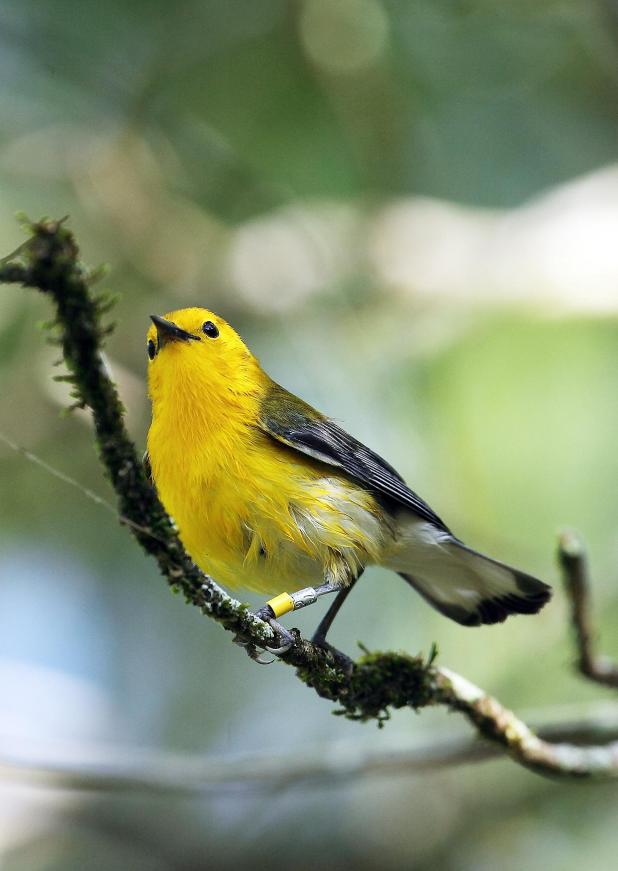
Flores’s banded prothonotary warbler.
Go With the Flow: Close Encounters of the The Bird Kind
Several weeks back, I focused this column on the approaching peak period for the neotropic songbird migration, hoping to encourage readers to get out and do a little nature viewing. Two weeks ago, I did a presentation at the Jeanerette Museum for the formal opening of the “Art of Nature Exhibit,” educating those in the audience on where to go throughout the gulf south to view wildlife on public land in their natural settings. Moreover, encouraging them to do so.
In the coming weeks, you can be sure this column will switch back to topics dear to all of our hearts like fishing, with a few specifics on where to find fish and what they’re biting on. Perhaps we’ll talk about shooting and maybe off season practice. And, hopefully, I’ll come across some really neat human interest story that touches us all.
However, for now I want to get back to the birds and share with you a real neat personal experience. Moreover, if I don’t see another songbird this spring, my cup is so full from the encounter, I’m pretty sure I’ll be good for the remainder of the year.
During a birding trip at that “peak” period I mentioned last month, Mrs. Flores and I ventured out with our camera gear planning to hit several of our favorite songbird locations. Nature photography is our thing just as golf, bowling, or perhaps kayaking is someone else’s.
We woke up with the birds and targeted Lake Martin, particularly Rookery Road, as our first destination to launch into our photography adventure. Our mental anticipation meters were tipped pretty high to the positive side, in our hopes of catching some great images of a few songbirds.
Lying between Lafayette and Breaux Bridge, Lake Martin happens to be a critical habitat for songbirds. As such, the region is a perfect place to view trans-gulf migrants that we chase each spring. What’s more, it’s also home to the Cypress Island Preserve; a great place to start.
It was on the preserve’s boardwalk where I experience my encounter. Prothontary warblers were singing like a glee-club high up in the tall cypress and tupelo trees of the nature preserve. Then, every few seconds we’d see them darting about chasing one another. Their movement was so fast they were more like streaks of yellow than songbirds. But, even songbirds have to rest a moment.
In the low branches, just above my head, a prothonotary warbler decided to quit the chase and search the tree’s bark for a breakfast of insects. Every few seconds it would sit, then go back to its twig by twig search. I depressed the shutter button of my camera and reeled off a few bursts. That’s when I saw a band on the bird’s left leg.
No longer interested in a quality image, I aimed at the bird’s butt, trying to catch as many shots of its legs as I could from as many angles as I could.
We’re not talking about a duck or goose band here. This band is tiny. I had my telephoto lens zoomed out to its maximum 400mm. I knew I’d also have to crop the image as well when I got home to examine the band more closely.
My hope was to decipher enough numbers to be able to report them to the Bird Banding Laboratory at the Patuxent Wildlife Research Center in Maryland.
For the next several days I spent hours poring over the images. And, it wasn’t until I was confident with utmost assuredness, did I get online to report the numbers.
Unfortunately, the automated report came back via email stating my numbers were incorrect and the one I reported was from a tree swallow banded in 1973. I didn’t give up though. I contacted the bird banding laboratory’s person in charge of handling questions regarding Federal band encounters and recoveries.
Jo Ann Lutmerding, a biologist with the laboratory, handed me off to Jennifer Malpass, another biologist, who asked me to send her some photos. Two days later Malpass contacted me stating she found my bird and that I was off by one digit during my examination.
The Prothonatary Warbler was banded in 2015 as a hatch year female by Dr. Erik I. Johnson, Audubon Louisiana Director of Bird Conservation, near Breaux Bridge. With this information, it’s reasonable to assume that my bird, this spring, has made its fourth trans-gulf trip. What’s more, has returned to nest again this year near the location it was initially banded.
I know that I miss out on a lot of good fishing during April and May weekends each year. I figure I can always make up the lost fishing days. But, you’d be hard pressed to make up a day when you have a close encounter of the bird kind.
If you wish to make a comment, or have an anecdote, recipe, or story you wish to share you can contact John K. Flores by calling 985-395-5586 or reach him by email at gowiththeflo@cox.net or go to his FACEBOOK page Gowiththeflo Outdoors.
